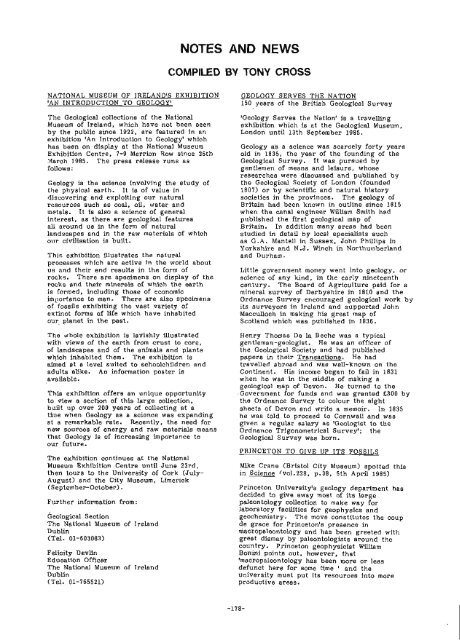Number 3 - Geological Curators Group
Number 3 - Geological Curators Group
Number 3 - Geological Curators Group
You also want an ePaper? Increase the reach of your titles
YUMPU automatically turns print PDFs into web optimized ePapers that Google loves.
COMPILED BY TONY CROSSNATIONAL. MUSEUM-OF IRELANII'S ~XHIBITION'r\tl INTRO1)UCTION 'TO GEO1.OGY'The <strong>Geological</strong> collections of the NationalMuseum of Ireland, which have not been seenby the public since 1922, are featured in anexhibition 'An Introduction to Geology' whichhas been on display at the National MuseumExhibition Centre, 7-9 Merrion Row since 26th.',(arch 1985. The press release runs asfollows :Geology is the science involving the study ofthe physical earth. It is of value indiscovering and exploiting our naturalresources such as coal, oil, water andmetals. It is also a science of generalinterest, as there are geological featuresall around us in the form of naturallandscapes and in the raw materials of whichour civilisation is built.This exhibition illustrates the naturalprocesses which are active in the world aboutus and their end results in the form ofrocks. There are specimens on display of therocks and their minerals of which the earthis formed, including those of economicimportance to man. There are also specimensof fossils exhibiting the vast variety ofextinct forms of life which have inhabitedour planet in the past.The vvhole exhibition is lavishly illustratedwith views of the earth from crust to core,of landscapes and of the animals and plantswhich inhabited them. The exhibition isaimed at a level suited to schoolchildren andadults alike. An information poster isavailable.This exhibition offers an unique opportunityto view a section of this large collection,built up over 200 years of collecting at atime when Geology as a science was expandingat a remarkable rate. Recently, the need fornew sources of energy and raw materials meansthat Geology is of increasing importance toour future.The exhibition continues at the NationalMuseum Exhibition Centre until June 23rd,then tours to the University of Cork (July-August) and the City Museum. Limerick(September-October).Further information from:~eological SectionThe National Museum of IrelandDublin(Tel. 01-603063)Felicity DevlinEducation OfficerThe National Museum of IrelandDublin(Tel. 01-765521)GEOLOGY SERVES THE NATION150 years of the British <strong>Geological</strong> Survey'Geology Serves the Nation' is a travellingexhibition which is at the <strong>Geological</strong> Museum,London until 13th September 1985.Geology as a science was scarcely forty yearsold in 1835, the year of the founding of the<strong>Geological</strong> Survey. It was pursued bygentlemen of means and leisure, whoseresearches were discussed and published bythe <strong>Geological</strong> Society of London (founded1807) or by scientific and natural historysocieties in the provinces. The geology ofBritain had been known in outline since 1815when the canal engineer William Smith hadpublished the first geological map ofBritain. In addition many areas had beenstudied in detail by local specialists suchas G.A. Mantel1 in Sussex, John Phillips inYorkshire and N.J. Winch in Northumberlandand Durham.Little government money went into geology, orscience of any kind, in the early nineteenthcentury. The Board of Agriculture paid for amineral survey of Derbyshire in 1810 and theOrdnance Survey encouraged geological work byits surveyors in Ireland and supported JohnMacculloch in making his great map ofScotland which was published in 1836.Henry Thomas De la Beche was a typicalgentleman-geologist. He was an officer ofthe <strong>Geological</strong> Society and had publishedpapers in their Transactions. He hadtravelled abroad and was well-known on theContinent. His income began to fail in 1831when he was in the middle of making ageological map of Devon. He turned to theGovernment for funds and was granted 5300 bythe Ordnance Survey to colour the eightsheets of Devon and write a memoir. In 1835he was told to proceed to Cornwall and wasgiven a regular salary as 'Geologist to theOrdnance Trigonometrical Survey'; the<strong>Geological</strong> Survey was horn.PRINCETON TO GIVE UP ITS FOSSILSMike Crane (Bristol City Museum) spotted thisin Science (vo1.228, p.38, 5th April 1985)Princeton University's geology department hasdecided to give away most of its largepaleontoloav collection to make wav foriaboratory?~cilities for geophysics andgeochemistry. The move constitutes the couude grace for Princeton's presence inniacropaleontology and has been greeted withgreat dismay by paleontologists around thecountry. Princeton geophysicist WilliamBonini points out, however, that'macropaleontology has been more or lessdefunct here for some time ' and theuniversity must put its resources into moreproductive areas.
















